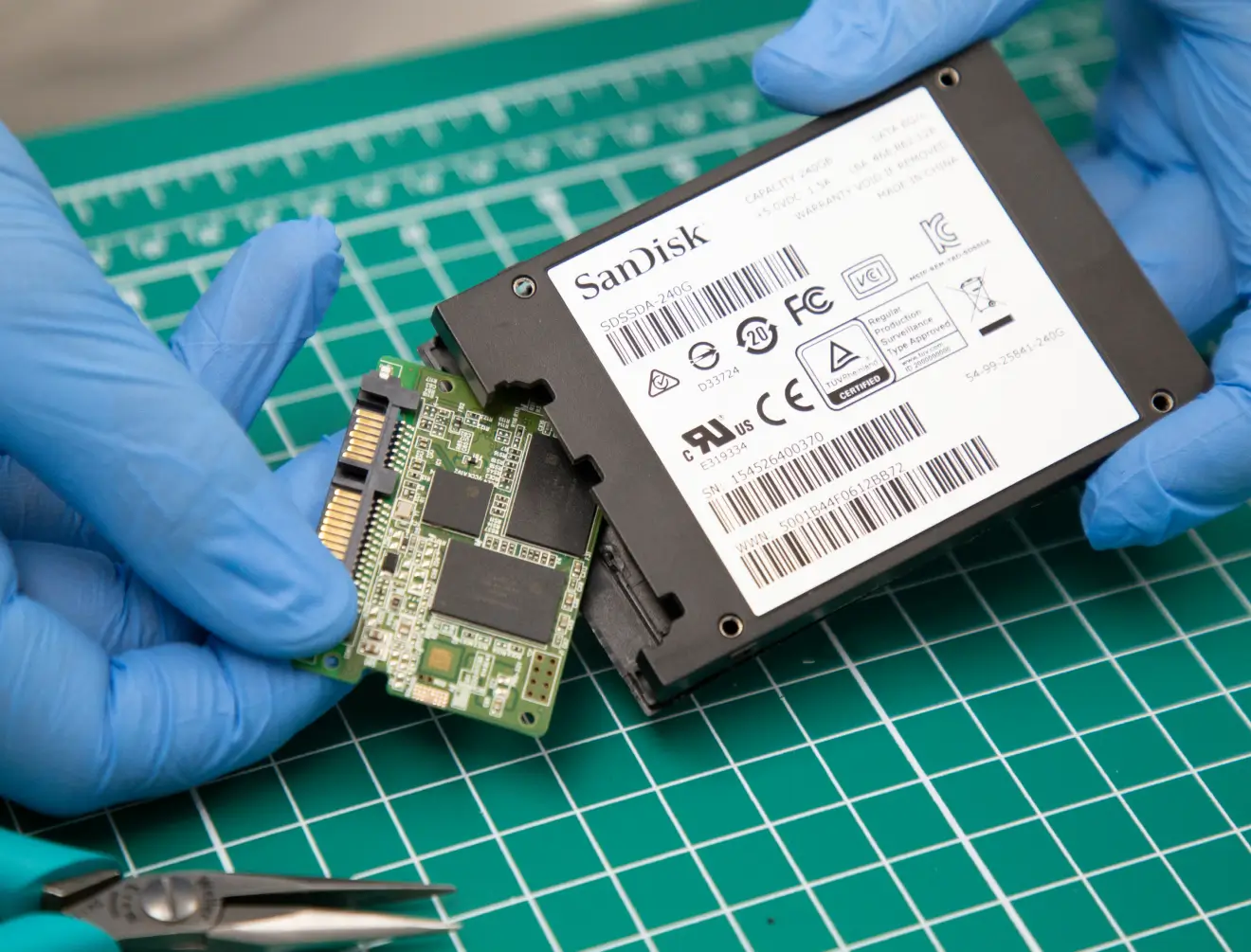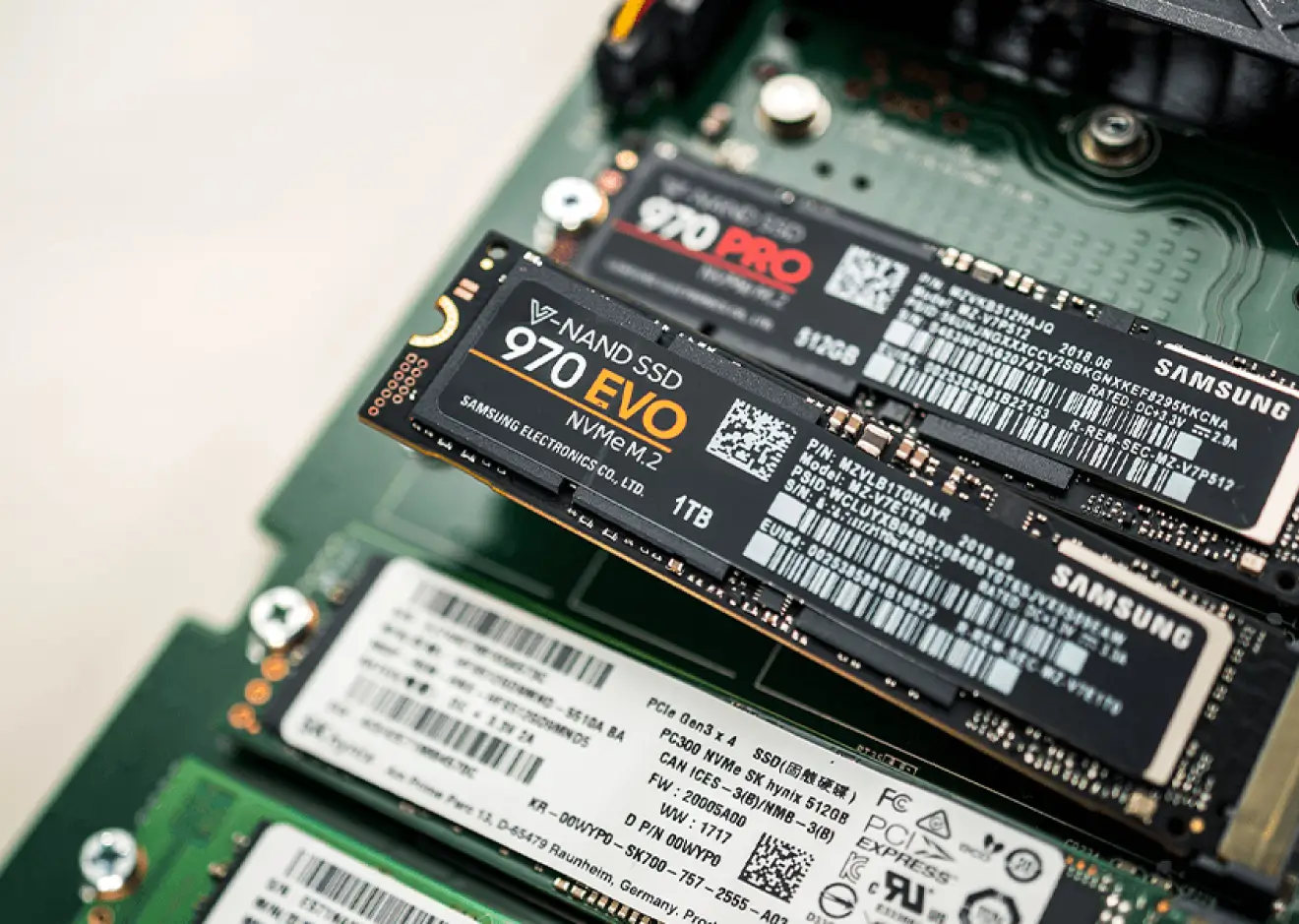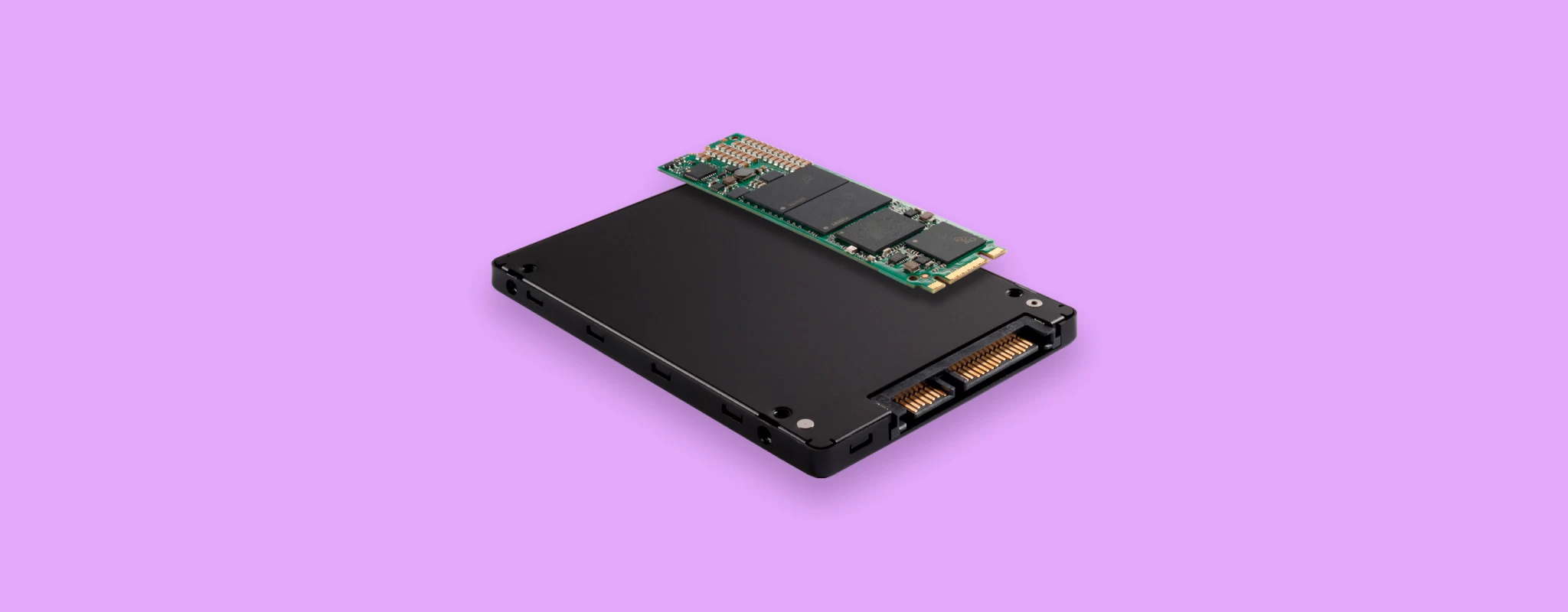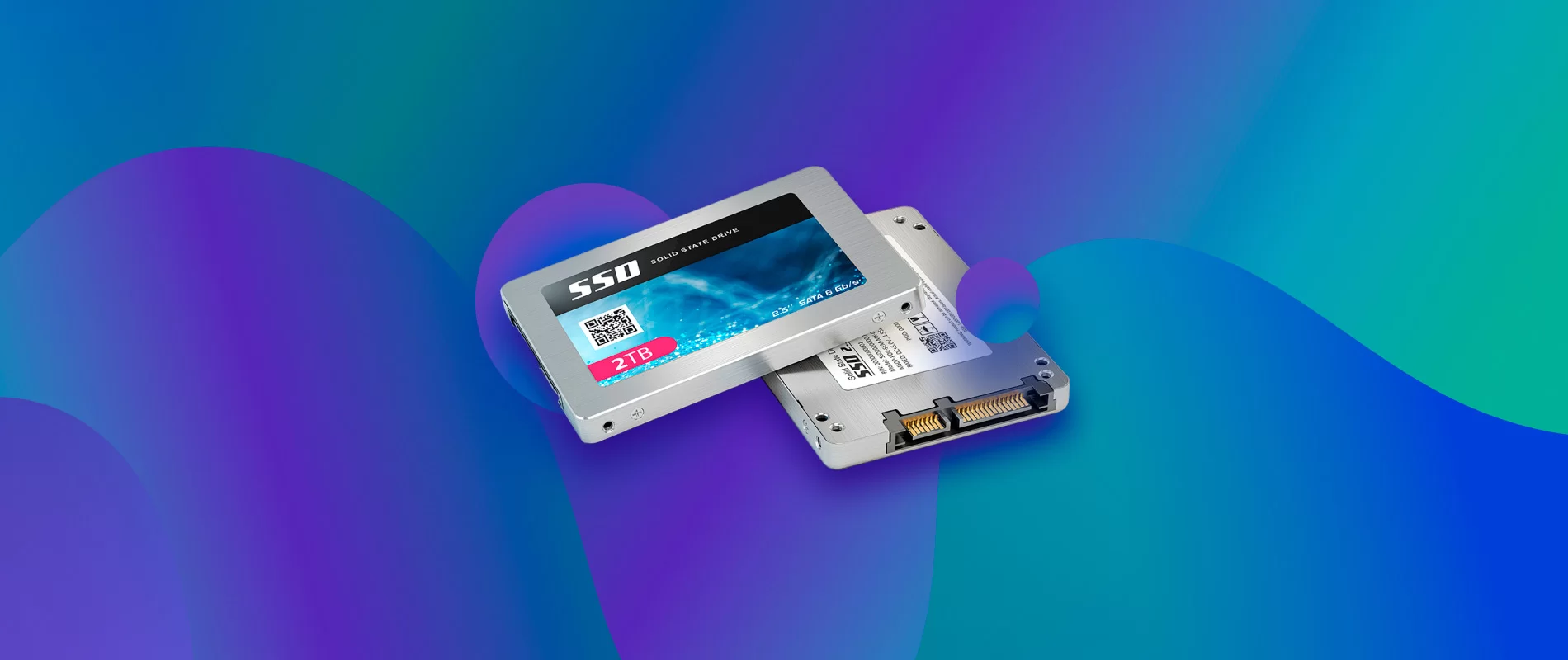Introduction
Welcome to our comprehensive guide on how to determine if a solid-state drive (SSD) is dead. SSDs have become increasingly popular due to their enhanced performance and reliability compared to traditional hard drives. However, like any electronic device, SSDs can fail over time.
Identifying whether your SSD is dead or malfunctioning is crucial to prevent data loss and to take appropriate steps to restore functionality. In this article, we will explore the common symptoms that indicate a dead SSD and provide troubleshooting steps to help you assess and potentially revive your drive.
Whether you’re a tech enthusiast, a professional managing critical data, or just a casual user experiencing issues with your SSD, understanding the signs of a dead SSD can save you time, money, and frustration.
Throughout this guide, we will discuss the various symptoms that may suggest your SSD is dead or on the verge of failure. These symptoms include being unable to access data, experiencing slow performance, encountering the dreaded Blue Screen of Death (BSOD), noticing files and folders suddenly disappear, experiencing frequent system crashes or freezing, receiving SMART status warnings, or being unable to boot or install an operating system.
While it’s important to note that these symptoms do not guarantee an SSD failure, they can provide valuable indicators of potential issues. By identifying these indicators, you can take the necessary steps to troubleshoot and, if needed, seek professional assistance to repair or replace your SSD.
Now, let’s dive deeper into each of these symptoms and explore the troubleshooting steps necessary to determine if your SSD is indeed dead or if there’s hope for recovery.
Symptoms of a Dead SSD
An SSD can exhibit various signs when it is dead or approaching failure. Identifying these symptoms is crucial to take appropriate actions to mitigate data loss and restore functionality. Here are the common indicators that your SSD might be dead:
1. Unable to Access Data: One of the telltale signs of a dead SSD is the inability to access any data stored on the drive. When you attempt to access files or folders, the system may display error messages or fail to recognize the drive altogether.
2. Slow Performance: A significant decrease in the SSD’s read and write speeds is another indicator of potential failure. If you notice a significant drop in performance when accessing or transferring files, it’s a sign that the SSD’s internals may be malfunctioning.
3. Blue Screen of Death (BSOD): If your computer frequently experiences the Blue Screen of Death (BSOD) with error codes related to disk failure or storage devices, it could be due to a dead or dying SSD. The BSOD occurs when the operating system encounters critical errors, indicating a potential hardware problem.
4. Files and Folders Suddenly Disappear: When an SSD begins to fail, files and folders stored on the drive may suddenly disappear or become corrupted. This can be particularly alarming if important data or documents are lost without warning.
5. System Crashes or Freezes Frequently: If your computer crashes or freezes frequently, it could be a sign of a failing SSD. When the SSD’s internal components deteriorate, the system may become unstable, leading to frequent crashes or freezes during normal usage.
6. SMART Status Warnings: SMART (Self-Monitoring, Analysis, and Reporting Technology) is a feature built into modern SSDs that monitors their health and reports potential issues. If your computer displays SMART warnings indicating imminent failure or a high number of bad sectors, it’s time to consider the possibility of a dead SSD.
7. Unable to Boot or Install Operating System: If your computer cannot boot into the operating system or encounters error messages during the installation process, a dead or malfunctioning SSD might be the culprit. The inability to boot or install an operating system is a significant indication of SSD failure.
These symptoms, while indicative of potential SSD failure, do not guarantee that your SSD is dead. It is crucial to perform further troubleshooting steps to confirm the diagnosis and take appropriate action.
In the following sections, we will guide you through the necessary troubleshooting steps to help you determine the state of your SSD and potentially revive it. Remember to back up your important data regularly to avoid permanent loss in case of SSD failure.
Unable to Access Data
One of the most common symptoms of a dead SSD is the inability to access any data stored on the drive. When you encounter this issue, it can be frustrating and concerning, especially if valuable files and documents are at stake. Here are some potential causes and troubleshooting steps to address the problem:
1. Check Physical Connections: Ensure that the SSD is properly connected to your computer. Make sure the SATA and power cables are securely plugged into both the SSD and the motherboard. Sometimes, a loose connection can prevent the SSD from being recognized by the computer.
2. Test on a Different Computer: To determine if the issue is specific to your computer or the SSD itself, try connecting the drive to a different computer. If the SSD remains inaccessible on multiple computers, it indicates a problem with the drive itself.
3. Update SSD Firmware: Outdated firmware can cause compatibility issues and prevent the SSD from being recognized. Check the manufacturer’s website for any available firmware updates for your specific SSD model, and follow the instructions provided to update the firmware.
4. Run Disk Check Utility: Use the built-in disk check utility in your operating system to scan and repair any potential file system errors. In Windows, you can run the “chkdsk” command in command prompt or use the Disk Utility in macOS to perform disk repairs.
5. Replace Power and SATA Cables: Faulty or damaged power and SATA cables can prevent the SSD from functioning correctly. Try using different cables to connect the SSD and see if the issue persists. If the SSD becomes accessible with new cables, it indicates that the previous cables were causing the problem.
6. Seek Professional Assistance: If none of the above steps resolve the issue, it’s possible that your SSD has experienced hardware failure. In such cases, it is recommended to contact the manufacturer’s customer support or bring your SSD to a professional data recovery service provider for further assistance.
It is important to note that attempting any data recovery steps yourself may pose a risk of permanent data loss. Therefore, it is recommended to consult with professionals who have the necessary expertise and tools to recover data from a failed or dead SSD.
In the next sections, we will explore additional symptoms and troubleshooting steps to help you diagnose the condition of your SSD and take appropriate actions accordingly.
Slow Performance
If you notice a significant decrease in the performance of your solid-state drive (SSD), it could be an indication of potential hardware issues or a dying SSD. Slow performance can manifest in various ways, such as longer boot times, sluggish file transfers, or delays when opening applications. Here are some potential causes and troubleshooting steps to address the slow performance of your SSD:
1. Check for Firmware Updates: Outdated firmware can affect the performance and compatibility of your SSD. Visit the manufacturer’s website and look for any available firmware updates specifically designed for your SSD model. Follow the provided instructions to update the firmware and potentially improve the drive’s performance.
2. Check for TRIM Support: TRIM is a command that allows the operating system to inform the SSD which blocks of data are no longer in use and can be erased. Ensure that TRIM is enabled on your system, as it helps maintain SSD performance over time. On Windows, you can verify TRIM status by opening Command Prompt and running the “fsutil behavior query DisableDeleteNotify” command.
3. Check Storage Capacity: SSD performance can be adversely affected when it reaches near its maximum storage capacity. This can be due to a lack of free space needed for efficient operation and wear leveling algorithms. Consider freeing up space on your SSD by removing unnecessary files or transferring them to other storage devices.
4. Run Disk Optimization: Use the built-in disk optimization tools provided by your operating system to improve the performance of your SSD. In Windows, you can run the “Optimize Drives” utility by searching for it in the Start menu. This tool analyzes and optimizes the placement of files on the SSD, ensuring efficient read and write operations.
5. Check for Background Processes: Certain background processes or applications may be causing excessive disk usage and slowing down your SSD. Use the Task Manager (Windows) or Activity Monitor (macOS) to identify any resource-intensive processes and consider closing or disabling them temporarily to improve performance.
6. Scan for Malware: Malware or viruses can negatively impact the performance of your SSD. It is important to regularly scan your system with reliable antivirus software to detect and remove any malicious programs that may be causing performance issues.
7. Consider Hardware Limitations: Certain older SSD models or lower-end options may have inherent performance limitations. If you have exhausted all other troubleshooting steps and still experience slow performance, it might be worth considering an upgrade to a faster SSD to achieve the desired performance.
If you have tried the above steps and the slow performance issue persists, it could be an indication of a failing SSD. In such cases, it is recommended to back up your important data and consider seeking professional assistance or replacing the SSD to avoid potential data loss.
In the following sections, we will discuss additional symptoms and troubleshooting steps to help you assess the condition of your SSD and determine the appropriate course of action.
Blue Screen of Death (BSOD)
Experiencing a Blue Screen of Death (BSOD) can be a distressing sight for any computer user. If you frequently encounter BSODs with error codes related to disk failure or storage devices, it may be an indication of a dead or dying solid-state drive (SSD). Here are some potential causes and troubleshooting steps to address the issue:
1. Check for Latest Drivers: Outdated or incompatible drivers can cause conflicts and lead to BSOD errors. Ensure that you have the latest drivers installed for your SSD and other hardware components. Visit the manufacturer’s website or use a reliable driver update tool to check for and install any available driver updates.
2. Update Firmware: Like drivers, outdated firmware can also contribute to compatibility and stability issues. Check the manufacturer’s website for firmware updates specifically designed for your SSD model and follow the provided instructions to update the firmware.
3. Verify Cable Connections: Ensure that the SATA data and power cables connecting the SSD to the motherboard are securely plugged in. Loose or faulty connections can trigger BSOD errors. Try reseating the cables or swapping them with known good cables.
4. Run System File Checker: The BSOD errors could be caused by corrupted system files. Run the System File Checker (SFC) utility to scan and repair any corrupted system files. Open Command Prompt as an administrator, then type “sfc /scannow” and hit Enter. Allow the utility to complete the scan and follow any repair prompts.
5. Scan for Malware: Malware or viruses can also cause BSOD errors. Use a reputable antivirus or malware detection software to perform a thorough scan of your computer. If any malware is detected, follow the software’s instructions to remove it.
6. Check Memory Issues: Faulty RAM or memory modules can sometimes trigger BSOD errors. Run the Windows Memory Diagnostic tool to check for memory-related issues. Open the Start menu, search for “Windows Memory Diagnostic,” and follow the on-screen instructions to scan your computer’s memory.
7. Seek Professional Assistance: If the BSOD errors persist after following the above steps, it may indicate a more serious issue with the SSD. Contact the manufacturer’s customer support or consult with a professional technician to thoroughly diagnose the problem and determine the appropriate solution.
Keep in mind that encountering an occasional BSOD does not necessarily mean your SSD is dead. However, frequent and recurring BSOD errors related to disk failure should be taken seriously and addressed promptly to prevent any potential data loss or further damage to your system.
In the subsequent sections, we will explore additional symptoms and troubleshooting steps to help you evaluate the condition of your SSD and take appropriate actions to resolve any potential issues.
Files and Folders Suddenly Disappear
Experiencing the sudden disappearance of files and folders from your solid-state drive (SSD) can be a distressing and alarming situation. This unexpected occurrence may indicate potential issues with the SSD or related hardware. Here are some possible causes and troubleshooting steps to address the problem:
1. Check Hidden Files and Folders: Sometimes, files and folders can become hidden due to incorrect settings or malware activity. Enable the display of hidden files and folders in the file explorer settings of your operating system and check if the missing files and folders reappear.
2. Use File Recovery Software: If your files and folders are not simply hidden, they may have been accidentally deleted or become corrupted. Utilize reliable file recovery software to scan your SSD and attempt to recover the missing or deleted data. However, it’s important to note that the success of file recovery largely depends on the extent of data damage or overwriting.
3. Check for Malware or Virus Infections: Malicious software or viruses can cause files and folders to disappear or become inaccessible. Run a reputable antivirus or malware detection program to scan your system and eliminate any potential malware infections.
4. Check Drive for Physical Damage: Physical damage to the SSD or its connections can result in files and folders disappearing. Inspect the SSD and connections for any signs of physical damage, such as bent pins or loose connections. If physical damage is detected, consult a professional technician or contact the SSD manufacturer for further guidance.
5. Restore from Backup: If you have a recent backup of your SSD data, restore the missing files and folders from your backup. Regularly backing up your important data is essential to minimize the impact of data loss in situations like this.
6. Seek Professional Assistance: If the above steps do not resolve the issue and your files and folders are still missing, it may indicate a more severe problem with your SSD. Contact the manufacturer’s customer support or consult with a professional data recovery service to seek their expertise and determine the appropriate course of action.
It’s essential to note that sudden disappearance of files and folders does not always indicate a dead SSD. Sometimes, it could be due to software glitches, user errors, or other factors. However, taking prompt action and following the troubleshooting steps above can help identify the root cause and potentially recover your missing data.
In the following sections, we will explore additional symptoms and troubleshooting steps to further evaluate the condition of your SSD and determine the necessary actions to address any potential issues.
System Crashes or Freezes Frequently
If your computer frequently crashes or freezes, it can be a frustrating and disruptive experience. Frequent system crashes or freezes can be indicative of potential issues with your solid-state drive (SSD) or related components. Here are some potential causes and troubleshooting steps to address this problem:
1. Check for Overheating: Excessive heat can cause system instability and lead to crashes or freezes. Ensure that your computer’s cooling system is functioning properly and that the ventilation areas are clear of dust and debris. Consider using additional cooling solutions if necessary.
2. Perform a System Scan: Run a thorough scan for malware or viruses using reliable antivirus software. Malicious software can disrupt system operations and cause crashes or freezes. Remove any detected threats and regularly update your antivirus software to protect your system.
3. Update Device Drivers: Outdated or incompatible device drivers can cause conflicts and system instability. Update your SSD’s drivers, as well as other hardware drivers, by visiting the manufacturer’s website or using a trusted driver update tool. Keeping your drivers up to date can improve compatibility and stability.
4. Check for Software Conflicts: Incompatible or poorly coded software can lead to crashes or freezes. Review any recently installed software or updates and check if the crashes started occurring after their installation. Consider uninstalling or updating the problematic software to resolve the issue.
5. Test Memory and RAM: Faulty memory modules or RAM can cause system instability. Use diagnostic tools like Windows Memory Diagnostic or third-party software to test your memory for errors. If errors are detected, replace the faulty memory modules to ensure system stability.
6. Verify Storage Health: Use the SMART (Self-Monitoring, Analysis, and Reporting Technology) feature to monitor the health of your SSD. SMART software can provide information about the SSD’s overall health, potential failures, or errors. If the utility detects any issues, it might be an indication of SSD failure.
7. Seek Professional Assistance: If the crashes or freezes persist after attempting the above steps, it may indicate a more severe issue with your SSD or other hardware components. Contact the manufacturer’s customer support or consult with a professional technician to thoroughly diagnose the problem and determine the appropriate solution.
Regular backups of your important data are crucial to minimize the impact of system crashes or freezes. This way, you can restore your data after resolving the underlying issue without significant loss.
Remember that system crashes or freezes can be caused by various factors, and it might not always be directly related to a dead SSD. Properly diagnosing the root cause is essential to take the appropriate actions and restore system stability.
In the next sections, we will explore additional symptoms and troubleshooting steps to help you evaluate the condition of your SSD and determine the necessary actions to address any potential issues.
SMART Status Warnings
S.M.A.R.T. (Self-Monitoring, Analysis, and Reporting Technology) is a feature built into modern solid-state drives (SSDs) that monitors the health and performance of the drive. When a SMART status warning is displayed, it indicates potential issues or abnormalities that could lead to SSD failure. Here are some key points to understand about SMART status warnings and steps you can take to address them:
Understanding SMART Status: SMART technology tracks various parameters of the SSD, such as read and write error rates, temperature, reallocated sectors, and more. When any of these parameters exceed acceptable thresholds, a SMART status warning is triggered, indicating a potential problem with the drive.
Interpreting SMART Status Warnings: Different manufacturers may provide varying interpretations for SMART status warnings. It’s essential to consult the SSD manufacturer’s documentation or support resources to understand the specific warning message and its implications for your particular SSD model.
Backup Your Data: When you receive a SMART status warning, it’s crucial to back up your important data immediately. SMART warnings often indicate potential disk failure, and there is a risk of data loss if the drive deteriorates further.
Update SSD Firmware: Outdated firmware can sometimes result in false or incorrect SMART warnings. Check the SSD manufacturer’s website for any available firmware updates for your specific model and follow the instructions to update the firmware. This may resolve false warnings or improve SSD performance.
Monitor Temperature and Ventilation: High temperatures can accelerate SSD degradation and trigger SMART warnings. Make sure your computer’s ventilation is adequate and that the SSD is not exposed to excessive heat. Consider using additional cooling solutions if your system’s temperature is consistently high.
Run Diagnostic Tools: Many SSD manufacturers provide diagnostic software that can evaluate the health and performance of your SSD. Run these tools to obtain detailed information about the drive’s condition and identify any specific issues contributing to the SMART warnings. The diagnostic tools may also provide recommendations or additional steps to address the problem.
Seek Professional Assistance: If you continue to receive SMART warnings or the drive’s performance deteriorates further, it may be necessary to seek professional assistance. Contact the SSD manufacturer’s customer support or consult with a qualified technician for further evaluation and guidance.
Remember that SMART status warnings should not be ignored, as they often signal potential SSD failure. It’s crucial to take proactive steps to minimize the risk of data loss and ensure the long-term functionality of your SSD.
In the following sections, we will explore additional symptoms and troubleshooting steps to help you evaluate the condition of your SSD and determine the necessary actions to address any potential issues.
Unable to Boot or Install Operating System
If you’re experiencing issues with booting or installing an operating system (OS) on your computer, it can be frustrating and prevent you from accessing your data or using your system. In many cases, these issues can be attributed to problems with the solid-state drive (SSD). Here are some potential causes and troubleshooting steps to address the problem:
1. Check Boot Priority Settings: Ensure that your computer’s BIOS or UEFI settings are configured to prioritize the SSD as the boot device. If the SSD is not set as the primary boot device, the computer may fail to recognize and load the operating system. Access the BIOS or UEFI settings by pressing the designated key during the boot process and adjust the boot priority accordingly.
2. Verify Cable Connections: Check the physical connections of the SSD, including the SATA data and power cables. Loose or faulty connections can prevent the SSD from being detected by the computer and cause booting or installation issues. Ensure that the cables are securely and properly connected to the SSD and the motherboard.
3. Test on a Different Computer: Connect the SSD to a different computer to determine whether the issue lies with the SSD or your specific computer. If the SSD is not recognized or the booting issue persists on multiple computers, it may indicate a problem with the drive itself.
4. Update SSD Firmware: Outdated firmware can sometimes cause compatibility issues that prevent the SSD from being detected or used as the boot drive. Visit the SSD manufacturer’s website and check for any available firmware updates specifically designed for your model. Follow the provided instructions to update the firmware.
5. Run Disk Management: Access the Disk Management utility in your operating system to check if the SSD is recognized and properly partitioned. If the SSD appears as unallocated or without a partition, you may need to create a new partition and format it to make it usable as a bootable device. Be cautious when performing disk management tasks to avoid accidentally deleting partitions or data.
6. Use Boot Repair Tools: Many operating systems provide built-in boot repair tools that can fix common booting issues. Access these tools through the “Automatic Repair,” “Startup Repair,” or similar options available during the OS installation or recovery process. These tools can repair the boot configuration and files to enable successful booting from the SSD.
7. Seek Professional Assistance: If all else fails, it is advisable to seek professional assistance from the SSD manufacturer’s customer support or consult with a qualified technician. They can perform advanced diagnostics and provide expert guidance to resolve the booting or installation issues when dealing with a potentially faulty SSD.
Remember to back up your important data regularly to minimize the risk of data loss during troubleshooting or potential SSD failure. This ensures that you can restore your data even if you need to replace the SSD.
In the subsequent sections, we will explore additional symptoms and troubleshooting steps to help you evaluate the condition of your SSD and determine the necessary actions to address any potential issues.
Troubleshooting Steps
If you’re experiencing issues with your solid-state drive (SSD) and suspect it may be dead or malfunctioning, there are several troubleshooting steps you can take to assess the condition of the drive and potentially resolve the problem. Here are some key steps to help you troubleshoot your SSD:
1. Check Physical Connections: Ensure that the SSD is properly connected to your computer. Verify that the SATA data and power cables are securely plugged into both the SSD and the motherboard. A loose or faulty connection can prevent the SSD from functioning correctly.
2. Test the SSD on a Different Computer: Connecting the SSD to a different computer can help determine if the issue is specific to your computer or the SSD itself. If the SSD remains unresponsive or exhibits the same issues on multiple computers, it suggests a problem with the drive.
3. Update SSD Firmware: Outdated firmware can cause compatibility issues and affect the performance of your SSD. Visit the manufacturer’s website for any available firmware updates specifically designed for your SSD model. Follow the provided instructions to update the firmware and potentially improve the drive’s functionality.
4. Run Disk Check Utility: Use the built-in disk check utility in your operating system to scan and repair any potential errors on the SSD. In Windows, you can run the “chkdsk” command in Command Prompt or use the Disk Utility in macOS to perform disk repairs. This can help identify and fix file system issues.
5. Replace Power and SATA Cables: Faulty or damaged power and SATA cables can contribute to SSD issues. Try using different cables to connect the SSD and see if the problem persists. If the SSD becomes responsive and functions properly with new cables, it indicates that the previous cables were causing the problem.
6. Conduct Data Backups: Before attempting any troubleshooting steps, it’s essential to back up your important data. This ensures that even if the SSD is irreparable, you have a copy of your files and can restore them onto a new drive.
7. Seek Professional Assistance: If the troubleshooting steps above do not resolve the issue and your SSD continues to exhibit problems, it is recommended to seek professional assistance. Contact the manufacturer’s customer support or consult with a professional data recovery service for expert advice on potential solutions.
Caution should be exercised throughout the troubleshooting process to avoid any further damage to the SSD or potential data loss. If you’re uncertain about performing any of the steps yourself, it’s best to consult with professionals who have the necessary expertise and tools to handle SSD-related issues.
By following these troubleshooting steps, you can assess the condition of your SSD and take appropriate actions to either resolve the problem or seek further assistance if necessary.
Check Physical Connections
Checking the physical connections of your solid-state drive (SSD) is an essential troubleshooting step when you suspect it may be dead or malfunctioning. Loose or faulty connections can prevent the SSD from functioning properly. Here’s how you can check the physical connections:
1. Power Off and Unplug: Before inspecting the physical connections, ensure that your computer is powered off completely. Unplug the power cable and any other peripheral devices connected to the computer.
2. Open the Computer Case: If your SSD is a desktop computer, remove the side panel of your computer case to access the internal components. If you’re unsure about this step, it’s recommended to refer to your computer’s manual or seek assistance from a professional.
3. Locate the SSD: Identify the SSD within your computer. It is typically a small rectangular drive connected to the motherboard via a SATA data cable and a power cable from the power supply unit (PSU).
4. Check SATA Data Cable: Ensure that the SATA data cable connecting the SSD to the motherboard is securely plugged in. Gently wiggle the cable to check for any looseness. If the connection is loose, remove the cable and reinsert it firmly into both the SSD and the motherboard’s SATA port.
5. Verify Power Cable Connection: Check the power cable connection to the SSD and ensure it is firmly connected. Power cables typically have a multi-pin connector that plugs into the SSD. Make sure it is inserted securely into the power connector on the SSD and the corresponding connector from the PSU.
6. Inspect for Physical Damage: While checking the connections, also inspect the SSD and cables for any physical damage. Look for bent pins, frayed cables, or any signs of wear, as these can cause issues with the SSD’s functionality.
7. Reassemble and Power On: After verifying and securing the connections, carefully reassemble the computer case and ensure all screws are tightened. Plug in the power cable and any peripherals, then power on the computer to check if the SSD is now functioning correctly.
Note: If you have a laptop or are uncomfortable opening the computer case, you may need to consult the device’s manual or contact the manufacturer’s customer support for guidance on verifying and securing the SSD connections.
By checking the physical connections of your SSD, you can address any loose or faulty connections that may be causing the issue. However, if the SSD continues to exhibit problems, further troubleshooting steps may be necessary.
In the following sections, we will explore additional symptoms and troubleshooting steps to help you evaluate the condition of your SSD and determine the necessary actions to address any potential issues.
Test on Different Computer
If you suspect that your solid-state drive (SSD) is dead or malfunctioning, a valuable troubleshooting step is to test the SSD on a different computer. This helps determine if the issue lies with the SSD itself or is specific to your computer. Here’s how you can perform this test:
1. Prepare a Different Computer: Find another computer that is compatible with your SSD. Ideally, this computer should have the same or similar specifications to ensure compatibility with the drive. If possible, select a computer with a different operating system to further eliminate any software-related issues.
2. Turn Off and Disconnect: Power off both your computer and the second computer completely. Unplug the power cables and any peripheral devices connected to both computers.
3. Remove the SSD: Open the case of your computer and carefully disconnect the SSD from its SATA data and power cables. If you’re uncertain about this step, consult your computer’s manual or seek assistance from a professional.
4. Connect the SSD to the Second Computer: Take your SSD and connect it to the second computer using the appropriate SATA data and power cables. Ensure that the connections are secure and properly seated.
5. Power On the Second Computer: With the SSD connected, plug in the power cable and any necessary peripherals for the second computer. Power on the computer and observe its behavior.
6. Check SSD Detection: Once the second computer is powered on, access the BIOS or UEFI settings by pressing the designated key during the boot process. Navigate to the hardware or storage section to confirm if the SSD is detected by the system. If the SSD is not detected, ensure that the connections are secure and try reconnecting the SSD.
7. Boot from Different Drive: If the SSD is detected, attempt to boot the second computer using a different drive, such as the computer’s primary HDD or another functional SSD. This step helps determine if the computer can boot successfully without relying on the SSD in question.
If the SSD is not detected or the second computer exhibits similar issues as the first, it suggests a problem with the SSD itself. In this case, further troubleshooting steps or professional assistance may be necessary to address the issue.
On the other hand, if the second computer detects and functions properly with the SSD, it indicates that the issue lies within the original computer or its configuration. This insight helps narrow down the potential causes and directs further troubleshooting efforts.
By testing the SSD on a different computer, you can isolate and identify whether the problem lies with the SSD or other components within your computer. This information is crucial for determining the appropriate actions to address any potential issues.
In the following sections, we will explore additional symptoms and troubleshooting steps to help you evaluate the condition of your SSD and determine the necessary actions to resolve any issues.
Update SSD Firmware
Updating the firmware of your solid-state drive (SSD) is an important step in troubleshooting and optimizing its performance. Firmware updates can address known issues, improve compatibility with hardware and software, and provide enhancements for your SSD. Here’s how you can update the firmware of your SSD:
1. Identify Your SSD Model: Determine the exact model of your SSD. You can usually find this information on the SSD itself, its packaging, or in your computer’s BIOS/UEFI settings. Make a note of the model name and number as it will be needed when accessing the manufacturer’s website.
2. Visit the SSD Manufacturer’s Website: Go to the official website of the SSD manufacturer. Look for the “Support,” “Downloads,” or “Drivers” section of the website. Some manufacturers have dedicated software or tools for firmware updates, while others provide firmware files directly for manual installation.
3. Locate the Firmware Update: Search for firmware updates specifically for your SSD model. Download the latest firmware update file indicated for your particular model onto your computer. Ensure that you download the correct firmware version compatible with your operating system.
4. Understand the Installation Process: Review the instructions provided by the manufacturer for installing the firmware update. Some manufacturers may provide a specific tool or utility to facilitate the update process, while others may require manual installation through a USB drive or other means.
5. Backup Your Data: Before proceeding with the firmware update, it’s essential to back up your data. Although firmware updates generally don’t involve data loss, it’s a precautionary measure to minimize the risk of accidental data loss due to any unforeseen circumstances during the update process.
6. Follow the Firmware Update Instructions: Carefully follow the instructions provided by the manufacturer for updating the SSD firmware. This may involve running an executable file, using a specific tool, or booting from a USB drive. Be sure to read and understand the instructions to avoid any potential issues.
7. Monitor the Update Process: During the firmware update, closely monitor the progress and ensure that the update completes successfully. Do not interrupt or power off your computer during the update process, as this can potentially damage the SSD or result in a failed firmware update.
8. Verify Firmware Update: After completing the firmware update, verify the updated firmware version in your computer’s BIOS/UEFI settings or through manufacturer-provided tools. Confirm that the firmware has been successfully updated to the latest version.
Updating the firmware of your SSD can help address known issues and improve the overall performance and compatibility of the drive. It’s important to periodically check for firmware updates and keep your SSD up to date to ensure optimal functionality.
In the subsequent sections, we will explore additional symptoms and troubleshooting steps to help you evaluate the condition of your SSD and determine the necessary actions to address any potential issues.
Run Disk Check Utility
If you’re experiencing issues with your solid-state drive (SSD), running a disk check utility can help identify and repair any potential file system errors. This built-in tool in your operating system allows you to scan and fix problems that may be affecting the performance and functionality of your SSD. Here’s how you can run a disk check utility:
1. In Windows:
– Open the Command Prompt as an administrator. Right-click on the Start menu, select “Command Prompt (Admin)” from the context menu.
– In the Command Prompt window, type the following command and press Enter: chkdsk C: (replace “C” with the drive letter assigned to your SSD).
– The disk check utility will scan the SSD for errors and display the results. If any issues are found, follow the prompted instructions to fix them.
2. In macOS:
– Open the Disk Utility application. You can find it in the “Utilities” folder within the “Applications” folder or by searching in Spotlight.
– In Disk Utility, select your SSD from the list of drives on the left sidebar.
– Click on the “First Aid” tab, then click the “Run” button to initiate the disk check utility.
– The utility will scan your SSD for errors and attempt to repair them if any are detected.
A disk check utility scans the file system and checks for issues such as bad sectors or file system corruption. It is a useful tool for detecting and rectifying problems with your SSD that may be causing performance or functionality issues.
Running a disk check utility is generally safe, but it’s always advisable to have a backup of your important data before proceeding, as the utility might make changes to the file system during the repair process.
If the disk check utility detects and resolves any issues, it could potentially resolve the problem you were experiencing with your SSD. However, note that this tool primarily focuses on file system errors and may not fix underlying hardware issues.
If the disk check utility does not resolve the problem or if it detects recurring errors, it’s recommended to seek further assistance from the manufacturer’s customer support or consult with a professional technician who specializes in SSD diagnostics.
In the following sections, we will explore additional symptoms and troubleshooting steps to help you evaluate the condition of your SSD and determine the necessary actions to address any potential issues.
Replace Power and SATA Cables
Faulty or damaged power and SATA cables can contribute to various issues with your solid-state drive (SSD), including performance problems, random disconnects, or complete failure. If you suspect that your SSD is experiencing connectivity issues, replacing the power and SATA cables can be an effective troubleshooting step. Here’s how you can replace these cables:
1. Power Off and Unplug: Shut down your computer completely and unplug the power cable from the electrical outlet. This ensures your safety during the cable replacement process.
2. Identify the Power and SATA Cables: Locate the power and SATA cables connected to your SSD. The power cable consists of a multi-pin connector that comes from the power supply unit (PSU), while the SATA cable connects to the motherboard and provides data transfer.
3. Remove the Old Cables: Gently disconnect the existing power and SATA cables from the SSD. For the power cable, carefully detach it from both the SSD’s power connector and the corresponding connector from the PSU. For the SATA cable, unplug it from the SSD’s SATA connector and the corresponding port on the motherboard.
4. Acquire Replacement Cables: Purchase new power and SATA cables that are compatible with your SSD and computer components. Ensure they meet the necessary specifications, such as the correct power connector type, SATA version, and length.
5. Connect the New Cables: Starting with the power cable, plug one end into the SSD’s power connector and the other end into the appropriate port on the PSU. Ensure a secure and proper connection. Next, take the new SATA cable and connect it to the SSD’s SATA connector and the corresponding port on the motherboard. Again, ensure a secure fit.
6. Reassemble and Power On: With the new cables in place, reassemble your computer system. Carefully close the case, ensuring that all screws are tightened. Plug in the power cable and any necessary peripherals. Power on your computer and observe if the connectivity issue has been resolved.
If the previous power or SATA cables were faulty or loose, replacing them can rectify the connectivity issue with your SSD. By using new and reliable cables, you can ensure a stable connection and proper functioning of your SSD.
If the replacement of power and SATA cables does not resolve the issue, it may indicate a different problem with your SSD or other hardware components. In such cases, it’s recommended to seek further assistance from the manufacturer’s customer support or consult with a professional technician.
Remember to handle cables with care, properly follow instructions, and refer to your computer’s manual if needed. Safety precautions and proper grounding are important when working with computer components.
In the subsequent sections, we will explore additional symptoms and troubleshooting steps to help you evaluate the condition of your SSD and determine the necessary actions to address any potential issues.
Conclusion
In this comprehensive guide, we have explored various symptoms and troubleshooting steps to help you determine if your solid-state drive (SSD) is dead or experiencing issues. Understanding the signs of a dead SSD is crucial for preventing data loss and taking appropriate actions to restore functionality. We covered symptoms such as the inability to access data, slow performance, Blue Screen of Death (BSOD) errors, files and folders disappearing, system crashes or freezes, SMART status warnings, and the inability to boot or install an operating system.
Throughout the troubleshooting process, we emphasized the importance of data backup to prevent permanent loss. We also provided guidance on checking physical connections, testing the SSD on a different computer, updating the SSD firmware, running disk check utilities, replacing power and SATA cables, and seeking professional assistance when necessary.
It’s crucial to remember that each SSD issue may have a different solution, and proper diagnosis is essential. While this guide offers valuable insights and troubleshooting steps, it’s always recommended to consult with the manufacturer, their customer support, or professional technicians for specific guidance tailored to your SSD model or situation.
Additionally, proactive measures such as keeping your SSD firmware up to date, regular backups, and maintaining a clean and optimized system can help prevent or minimize the occurrence of SSD issues in the future.
By following the troubleshooting steps outlined in this guide, you can evaluate the condition of your SSD and take the necessary actions to address any potential issues. Remember to exercise caution and seek professional assistance if needed to ensure the best outcome for your SSD and data.
We hope that this guide has been helpful in your journey to diagnose and resolve any problems with your SSD. If you have any further questions or require more specific assistance, don’t hesitate to reach out to the relevant technical support channels or professionals who specialize in SSD-related troubleshooting.

























